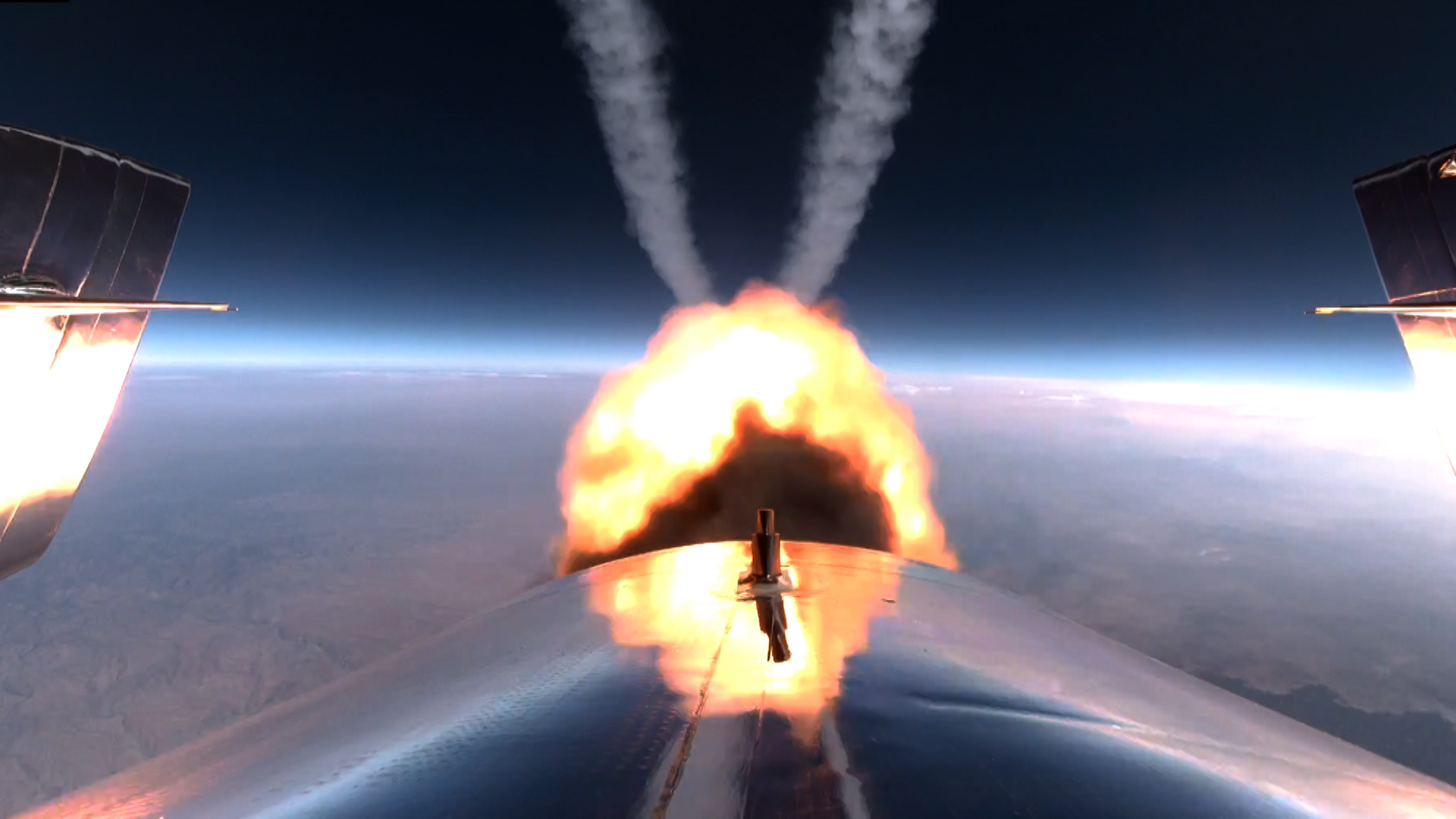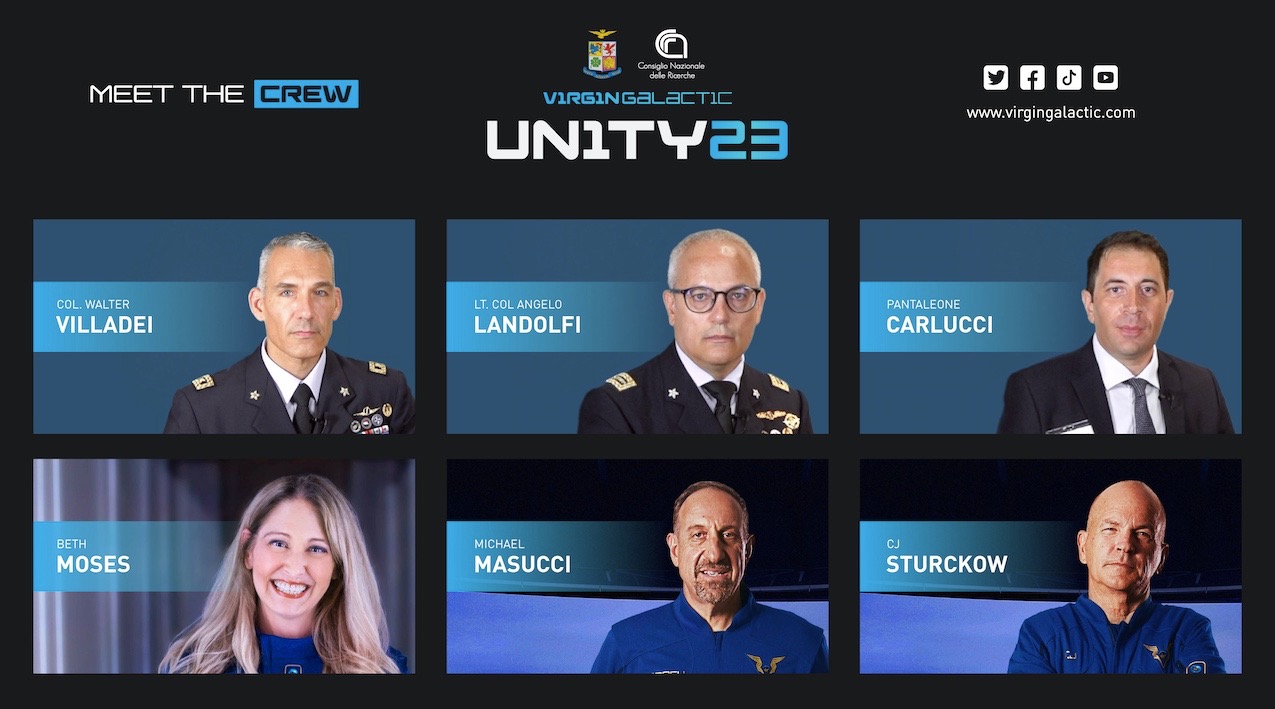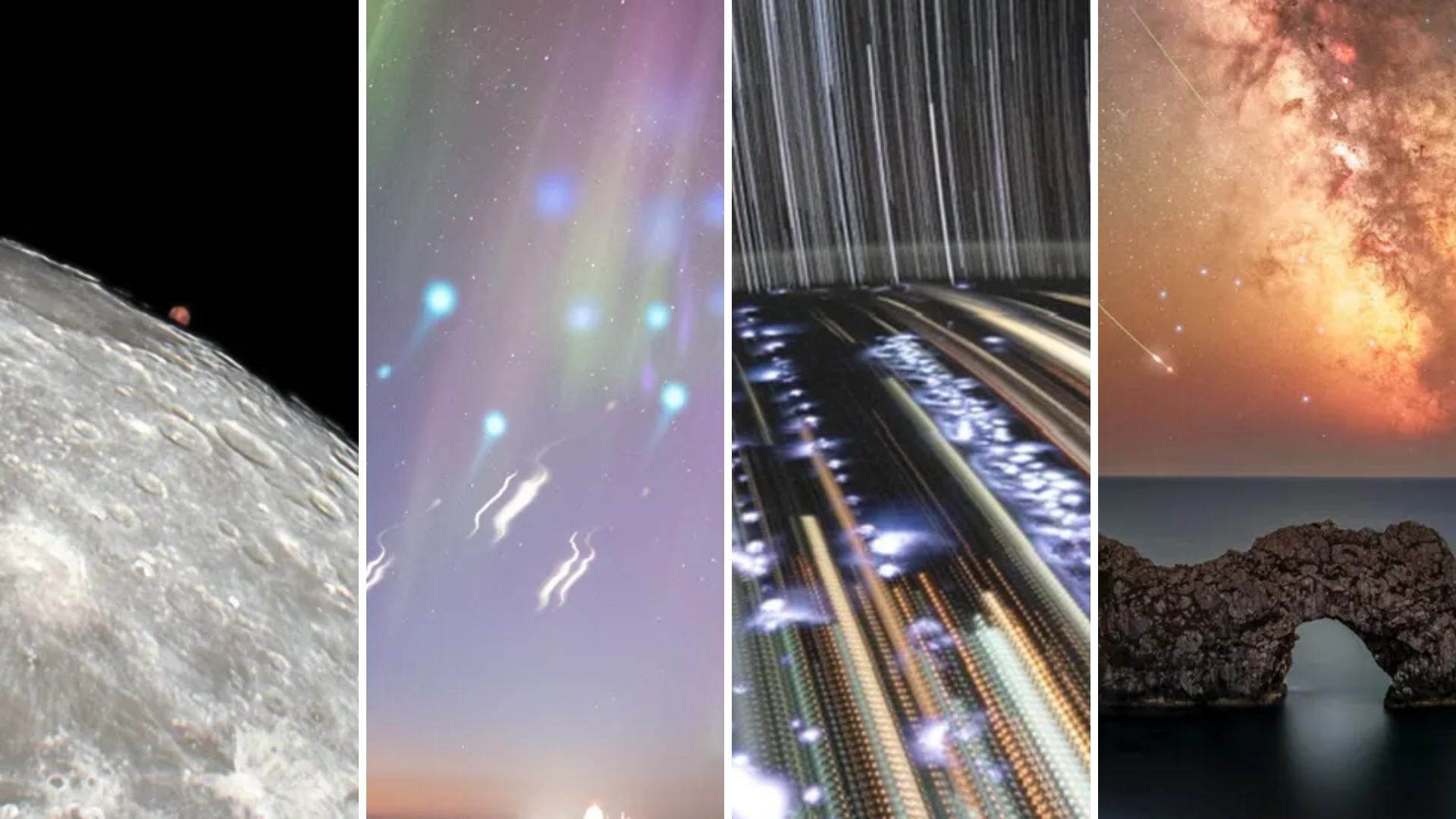Virgin Galactic announces crew for next launch to suborbital space

We now know who will be flying to suborbital space on Virgin Galactic's next mission.
That mission, a revenue-generating test flight of Virgin Galactic's VSS Unity space plane called Unity 23, is scheduled to launch in late September or early October. Virgin Galactic had previously announced that Unity 23 will fly members of the Italian Air Force, and on Thursday (Sept. 2) the company told us who those folks are and what they'll be doing.
Unity 23 will carry Italian Air Force Col. Walter Villadei and Lt. Col. Angelo Landolfi, as well as aerospace engineer Pantaleone Carlucci, a scientist with the Italian National Research Council, Virgin Galactic representatives said. Beth Moses, the company's chief astronaut instructor, will fly in the cabin with the Italian trio. Michael Masucci and C.J. Sturckow will pilot Unity, and Nicola Pecile and Kelly Latimer will fly VMS Eve, the space plane's carrier aircraft.
In photos: Virgin Galactic's 1st fully crewed spaceflight with Richard Branson

Villadei, an aerospace engineer who has trained as a cosmonaut, "will serve as mission lead, tending to the rack-mounted payloads during the weightless portion of the flight," Virgin Galactic representatives said in a statement Thursday. "He will wear a cutting-edge smart suit, incorporating Italian fashion style and technology, to measure his biometric data and physiological responses."
Landolfi, who's a physician, will perform experiments that assess cognitive performance in microgravity, as well as others that test how materials mix in a weightless environment. And Carlucci will wear sensors that measure heart rate and other important human-performance metrics.
"The Italian Air Force has always placed great importance on the understanding of space and aerospace. Aerospace is the natural operational extension of our institutional duty," Lt. Gen. Alberto Rosso, chief of staff of the Italian Air Force, said in the same statement.
Breaking space news, the latest updates on rocket launches, skywatching events and more!
"Strength in this domain is an asset for the country and is critical to its protection and safety, which is why the Air Force places great emphasis on further deepening its knowledge," Rosso added. "With this mission, the Italian Air Force aims to start exploring potential implementations for this kind of vehicle — both civilian and military — and to further opportunities for technological, scientific and industrial growth. We are thrilled to entrust this important mission to a flight pioneer such as Virgin Galactic."
Unity will lift off from Spaceport America in New Mexico beneath the wings of VMS Eve, a specially built twin-fuselage carrier plane. At an altitude of about 50,000 feet (15,000 meters), Eve will drop Unity, and the space plane will power its way to suborbital space using its onboard rocket motor.
The Unity 23 crewmembers will experience three to four minutes of weightlessness and see the curvature of Earth against the blackness of space. They'll then glide down to Earth for a runway landing back at Spaceport America.
Unity 23 will be the fifth space mission for VSS Unity and its 23rd flight overall (hence the name). The vehicle's most recent trip to the final frontier occurred on July 11, when Unity lofted Virgin Group founder Richard Branson and three Virgin Galactic employees in its cabin, as well as two pilots in the cockpit. That mission, called Unity 22, was the company's first fully crewed spaceflight.
VSS Unity flew outside its designated airspace for one minute and 41 seconds during that July 11 test flight, an incident that spurred an investigation overseen by the U.S. Federal Aviation Administration (FAA), Nicholas Schmidle reported in The New Yorker yesterday (Sept. 1). That investigation is ongoing, and Unity won't fly again until it wraps up to the FAA's satisfaction, Schmidle added in a tweet today.
"As we have previously stated, we are working in partnership with the FAA to address the short time that the spaceship dropped below its permitted altitude during the Unity 22 flight. We take this seriously and are currently addressing the causes of the issue and determining how to prevent this from occurring on future missions," a Virgin Galactic spokesperson told Space.com via email.
"Although the flight's ultimate trajectory deviated from our initial plan, it was a controlled and intentional flight path that allowed Unity 22 to successfully reach space and land safely at our Spaceport in New Mexico," the spokesperson added. "At no time were passengers and crew put in any danger as a result of this change in trajectory, and at no time did the ship travel above any population centers or cause a hazard to the public. FAA representatives were present in our control room during the flight and in post-flight debriefs. We have been working closely with the FAA to support a thorough review and timely resolution of this issue."
Whenever it lifts off, Unity 23 will be the vehicle's last spaceflight for a while. After the upcoming mission, Virgin Galactic plans to fly VMS Eve to Mojave, California, where the carrier aircraft will receive a series of "enhancements" — for example, the strengthening of various structural components. Eve is expected back at Spaceport America around the middle of next year.
Virgin Galactic laid out this timeline early last month during a call with investors. Also during that call, the company announced that it had begun selling seats on VSS Unity again, for $450,000 apiece. Virgin Galactic had halted ticket sales in December 2018; at that time, seats were going for $250,000 each.
Editor's note: This story was updated at 5:50 p.m. EDT to include a quote from Virgin Galactic about Unity 22 and the ongoing investigation into what happened on the flight.
Mike Wall is the author of "Out There" (Grand Central Publishing, 2018; illustrated by Karl Tate), a book about the search for alien life. Follow him on Twitter @michaeldwall. Follow us on Twitter @Spacedotcom or Facebook.

Michael Wall is a Senior Space Writer with Space.com and joined the team in 2010. He primarily covers exoplanets, spaceflight and military space, but has been known to dabble in the space art beat. His book about the search for alien life, "Out There," was published on Nov. 13, 2018. Before becoming a science writer, Michael worked as a herpetologist and wildlife biologist. He has a Ph.D. in evolutionary biology from the University of Sydney, Australia, a bachelor's degree from the University of Arizona, and a graduate certificate in science writing from the University of California, Santa Cruz. To find out what his latest project is, you can follow Michael on Twitter.
